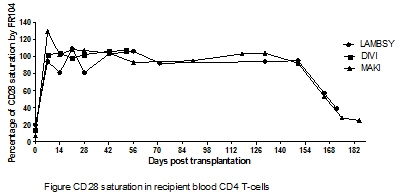CD28 Saturation by FR104, a Non-Activating CD28 Antagonist Fab in a Non-Human Primate Cardiac Allograft Model
1Dept of Surgery, University of Maryland School of Medicine, Baltimore, MD
2INSERM U643, Nantes, France.
Meeting: 2015 American Transplant Congress
Abstract number: D18
Keywords: Co-stimulation, Graft survival, Primates
Session Information
Session Name: Poster Session D: Costimulation and Signaling in Lymphocytes
Session Type: Poster Session
Date: Tuesday, May 5, 2015
Session Time: 5:30pm-6:30pm
 Presentation Time: 5:30pm-6:30pm
Presentation Time: 5:30pm-6:30pm
Location: Exhibit Hall E
Background: Targeting CD28 costimulation pathway with a selective antagonist is a promising approach in tolerance induction. The extent to which novel therapeutic antibodies reach their target antigens in primary and secondary lymphoid structures of primates has not been well addressed yet. FR104 is a novel humanized peggylated monovalent anti-CD28 Fab antagonist. Here we investigate the saturation of CD28 by FR104 after in-vivo injection in primates.
Methods. CD28 saturation was analyzed in the blood, mesenteric lymph nodes (LN), spleen (Spl) and thymus (Thy) the day after FR104 administration (10 mg/kg, IV, D-1) to three naïve cynomologus monkeys, and at multiple time points, in blood and LN of three cynomologus heterotopic heart allograft recipients that received multiple doses of FR104 therapy (10 mg/kg, IV, D0, 4, 14, 21, 28, 42, 56, 70 and 84). The CD28 saturation was assessed on CD4+ T cells by flow cytometry and expressed as the MFI ratio (%) by comparing αCD28-Tag binding before and after addition of excess FR104.
Results. CD28 saturation was 84±23% on blood CD4+ T cells and was slightly lower in the LN, spleen and thymus (67±25%, 62±3%, 68±8%) after a single dose of FR104. In two heart allograft recipients, CD28 showed 100% saturation in the blood during therapy [Figure 1]. One animal (out of 3) rejected its allograft at day 52 during ongoing treatment suggesting that CD28 blockade-independent pathway rejection can occur in this model. The other two animals survived long-term (175 and 182 days). CD28 saturation started to decrease in both recipient blood and LN after day 150 and was minimal at the time of rejection, suggesting that declining CD28 receptor coverage after cessation of treatment consistently anticipates graft failure.

Conclusions. We conclude that measuring CD28 receptor coverage in various immune compartments will be useful to learn whether FR104 efficacy correlates with CD28 coverage in those compartments, and to identify and evaluate mechanisms of CD28-independent rejection, when it occurs.
To cite this abstract in AMA style:
Sun W, Azimzadeh A, Braileanu G, Zhang T, Amoako D, Burdorf L, Vanhove B, III RPierson. CD28 Saturation by FR104, a Non-Activating CD28 Antagonist Fab in a Non-Human Primate Cardiac Allograft Model [abstract]. Am J Transplant. 2015; 15 (suppl 3). https://atcmeetingabstracts.com/abstract/cd28-saturation-by-fr104-a-non-activating-cd28-antagonist-fab-in-a-non-human-primate-cardiac-allograft-model/. Accessed December 24, 2025.« Back to 2015 American Transplant Congress
